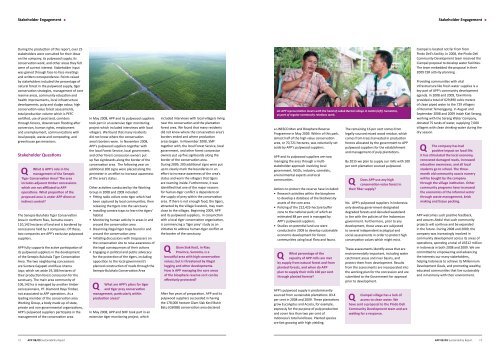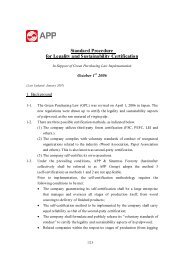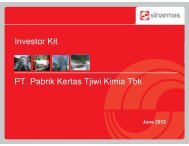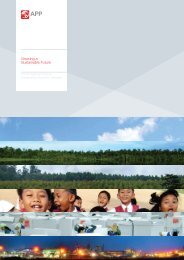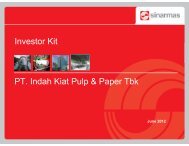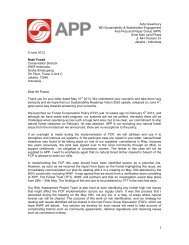APP Sustainability Report 2008-2009 - Asia Pulp and Paper
APP Sustainability Report 2008-2009 - Asia Pulp and Paper
APP Sustainability Report 2008-2009 - Asia Pulp and Paper
You also want an ePaper? Increase the reach of your titles
YUMPU automatically turns print PDFs into web optimized ePapers that Google loves.
Stakeholder Engagement<br />
Stakeholder Engagement<br />
During the production of this report, over 25<br />
stakeholders were consulted for their ideas<br />
on the company, its pulpwood supply, its<br />
conservation work, <strong>and</strong> other areas they felt<br />
were of current interest. Stakeholder input<br />
was gained through face-to-face meetings<br />
<strong>and</strong> written correspondence. Points raised<br />
by stakeholders included the percentage of<br />
natural forest in the pulpwood supply, tiger<br />
conservation strategies, management of core<br />
reserve areas, community education <strong>and</strong><br />
health improvements, local infrastructure<br />
developments, pulp <strong>and</strong> sludge odour, high<br />
conservation value forest assessments,<br />
total production volume which is PEFC<br />
certified, use of peat l<strong>and</strong>, corridors<br />
through forests, downstream flooding after<br />
conversion, human rights, employment<br />
<strong>and</strong> unemployment, communications with<br />
local people, waste <strong>and</strong> composting, <strong>and</strong><br />
greenhouse gas emissions.<br />
Stakeholder Questions<br />
Q<br />
What is <strong>APP</strong>’s role in the<br />
management of the Senepis<br />
Tiger Conservation Area? The area<br />
includes adjacent timber concessions<br />
which are not affiliated to <strong>APP</strong><br />
operations. What proportion of the<br />
proposed area is under <strong>APP</strong> direct or<br />
indirect control?<br />
The Senepis-Buluhala Tiger Conservation<br />
Area in northern Riau, Sumatra covers<br />
110,142 hectares of l<strong>and</strong> <strong>and</strong> is bordered by<br />
concessions held by 3 companies. Of these,<br />
two companies are <strong>APP</strong>’s exclusive pulpwood<br />
suppliers.<br />
<strong>APP</strong> fully supports the active participation of<br />
its pulpwood suppliers in the development<br />
of the Senepis-Buluhala Tiger Conservation<br />
Area. The two neighboring concessions<br />
are Suntara Gajapati <strong>and</strong> Ruas Utama<br />
Jaya; which set aside 19,186 hectares of<br />
their production forest concession for the<br />
sanctuary. The main area community of<br />
106,142 ha is managed by another timber<br />
concessionaire, PT. Diamond Raya Timber,<br />
not associated to <strong>APP</strong> operations. As a<br />
leading member of the conservation area<br />
Working Group, a body made up of state,<br />
private <strong>and</strong> non-governmental organizations,<br />
<strong>APP</strong>’s pulpwood suppliers participate in the<br />
management of the conservation area.<br />
In May <strong>2008</strong>, <strong>APP</strong> <strong>and</strong> its pulpwood suppliers<br />
took part in an extensive tiger monitoring<br />
project which included interviews with local<br />
villagers. We found that many residents<br />
did not know where the conservation<br />
area’s borders were. In November <strong>2008</strong>,<br />
<strong>APP</strong>’s pulpwood suppliers together with<br />
the local Forest Service, local government,<br />
<strong>and</strong> other forest concession owners put<br />
up five signboards along the border of the<br />
conservation area. The following year an<br />
additional 200 signs were placed along the<br />
perimeter in an effort to increase awareness<br />
of the area’s status.<br />
Other activities conducted by the Working<br />
Group in <strong>2008</strong> <strong>and</strong> <strong>2009</strong> included:<br />
• Fitting radio collars onto tiger which had<br />
been captured by local communities, then<br />
releasing the tigers into the sanctuary<br />
• Installing camera traps to learn the tigers’<br />
habitat<br />
• Monitoring human activity in areas in <strong>and</strong><br />
around the conservation area<br />
• Disarming illegal tiger traps found in <strong>and</strong><br />
around the conservation area<br />
• Initiating discussions with trespassers on<br />
the conservation site to raise awareness of<br />
the legal consequences of their actions<br />
• Engaging in political <strong>and</strong> public advocacy<br />
for the protection of the tigers, including<br />
opposition to the local government’s<br />
planned construction of roads through the<br />
Senepis-Buluhala Conservation Area<br />
Q<br />
What are <strong>APP</strong>’s plans for tiger<br />
<strong>and</strong> tiger prey conservation<br />
management, particularly within<br />
production areas?<br />
In May <strong>2008</strong>, <strong>APP</strong> <strong>and</strong> SMF took part in an<br />
extensive tiger monitoring project, which<br />
included interviews with local villagers living<br />
near the conservation <strong>and</strong> the plantation<br />
forest area. We found that many residents<br />
did not know where the conservation area’s<br />
borders ended <strong>and</strong> where production<br />
areas began. In November <strong>2008</strong>, SMF<br />
together with, the local Forest Service, local<br />
government, <strong>and</strong> other forest concession<br />
owners put up five signboards along the<br />
border of the conservation area.<br />
During <strong>2009</strong>, 200 additional signs were put<br />
up to clearly mark the boundaries in an<br />
effort to increase awareness of the area’s<br />
status <strong>and</strong> warn the villagers that tigers<br />
are roaming inside. Furthermore, it was<br />
identified that one of the major reasons<br />
for human-tiger conflict is dependent on<br />
the supply of prey within the conservation<br />
area. If there is not enough food, the tigers,<br />
attracted by the village livestock, may roam<br />
close to the villages. Beginning <strong>2009</strong>, <strong>APP</strong><br />
<strong>and</strong> its pulpwood suppliers, in conjunction<br />
with a local tiger conservation organization,<br />
is commencing a ‘tiger prey’ study as an<br />
initiative to address human-tiger conflict at<br />
the border of the sanctuary.<br />
Q<br />
Giam Siak Kecil, in Riau<br />
Province, Sumatra, is a<br />
beautiful area with high conservation<br />
values, but is threatened by illegal<br />
logging <strong>and</strong> other developments.<br />
How is <strong>APP</strong> managing the core areas<br />
of the biosphere reserve so it can be<br />
effectively protected?<br />
After five years of preparation, <strong>APP</strong> <strong>and</strong> its<br />
pulpwood suppliers succeeded in having<br />
the 178,000 hectare Giam Siak Kecil Bukit<br />
Batu (GSKBB) conservation area declared<br />
An <strong>APP</strong> representative meets with the head of Lubuk Bernai village in Jambi (left), Sumatera,<br />
as part of regular community relations work.<br />
a UNESCO Man <strong>and</strong> Biosphere Reserve<br />
Programme in May <strong>2009</strong>. Within of this park,<br />
almost half of the high value conservation<br />
area, or 70,721 hectares, was voluntarily set<br />
aside by <strong>APP</strong>’s pulpwood suppliers.<br />
<strong>APP</strong> <strong>and</strong> its pulpwood suppliers are now<br />
managing the area through a multistakeholder<br />
approach involving local<br />
government, NGOs, industry, scientists,<br />
environmental experts <strong>and</strong> local<br />
communities.<br />
Actions to protect the reserve have included:<br />
• Research activities within the biosphere<br />
to develop a database of the biodiversity<br />
assets of the core area<br />
• Policing of the 222,425-hectare buffer<br />
zone to the national park; of which an<br />
estimated 88 per cent is managed by<br />
<strong>APP</strong>’s pulpwood suppliers.<br />
• Studies on potential l<strong>and</strong> use were<br />
conducted in <strong>2009</strong> to develop sustainable<br />
economic development for forest<br />
communities using local flora <strong>and</strong> fauna.<br />
Q<br />
What percentage of the<br />
capacity of <strong>APP</strong> mills are met<br />
by supply from natural forest <strong>and</strong> from<br />
planted forests, <strong>and</strong> when do <strong>APP</strong><br />
plan to supply their mills 100 per cent<br />
through planted forests?<br />
<strong>APP</strong>’s pulpwood supply is predominantly<br />
sourced from sustainable plantations: 83.4<br />
per cent in <strong>2008</strong> <strong>and</strong> <strong>2009</strong>. These plantations<br />
grow Eucalyptus <strong>and</strong> Acacia, for example,<br />
expressly for the purpose of pulp production<br />
<strong>and</strong> cover less than two per cent of<br />
Indonesia’s total l<strong>and</strong> base. Planted species<br />
are fast growing with high yielding.<br />
The remaining 16 per cent comes from<br />
legally sourced mixed wood residue, which<br />
comes from trees harvested in production<br />
forests allocated by the government to <strong>APP</strong><br />
pulpwood suppliers for the establishment<br />
<strong>and</strong> management of pulp plantations.<br />
By 2015 we plan to supply our mills with 100<br />
per cent plantation sourced pulpwood.<br />
Q<br />
Does <strong>APP</strong> use any high<br />
conservation value forest in<br />
their fiber supply?<br />
No. <strong>APP</strong>’s pulpwood suppliers in Indonesia<br />
only develop government-designated<br />
degraded forests <strong>and</strong> denuded wastel<strong>and</strong><br />
in line with the policies of the Indonesian<br />
government. Furthermore, prior to any<br />
development, these areas are subjected<br />
to several independent ecological <strong>and</strong><br />
social assessments in order to protect high<br />
conservation values which might exist.<br />
These assessments identify areas that are<br />
environmentally important, including water<br />
catchment areas <strong>and</strong> river basins, <strong>and</strong><br />
protect them from development. Results<br />
from the assessments are incorporated into<br />
the working plan for the concession <strong>and</strong> are<br />
submitted to the Government for approval<br />
prior to development.<br />
Q<br />
Ciampel village has a lack of<br />
access to clean water. We<br />
have sent a proposal to the Pindo Deli<br />
Community Development team <strong>and</strong> are<br />
waiting for a response.<br />
Ciampel is located not far from from<br />
Pindo Deli’s facility. In <strong>2008</strong>, the Pindo Deli<br />
Community Development team received the<br />
Ciampel proposal to develop water facilities.<br />
The team embedded the proposal in their<br />
<strong>2009</strong> CSR activity planning .<br />
Providing communities with vital<br />
infrastructure like fresh water supplies is a<br />
key part of <strong>APP</strong>’s community development<br />
agenda. In <strong>2008</strong> <strong>and</strong> <strong>2009</strong>, Tjiwi Kimia<br />
provided a total of 629,890 cubic meters<br />
of clean piped water to the 729 villagers<br />
of Keramat Temenggung. In August <strong>and</strong><br />
September <strong>2008</strong> <strong>and</strong> <strong>2009</strong> Indah Kiat Serang,<br />
working with the Serang Water Company,<br />
donated 75 tanks of water, supplying 7,000<br />
villagers with clean drinking water during the<br />
dry season.<br />
Q<br />
The company has had<br />
positive impact on local life:<br />
it has stimulated the local economy,<br />
renovated damaged roads, increased<br />
education awareness, <strong>and</strong> all local<br />
students go to school. The threemonth<br />
old community acacia nursery<br />
will be bought by the company<br />
through the village institution. Other<br />
community programs have increased<br />
the economics of the informal sector<br />
through waste management, brick<br />
making <strong>and</strong> tissue packing.<br />
<strong>APP</strong> welcomes such positive feedback,<br />
<strong>and</strong> assures Abdul that such community<br />
projects will continue <strong>and</strong> be exp<strong>and</strong>ed<br />
in the future. During <strong>2008</strong> <strong>and</strong> <strong>2009</strong>, the<br />
company was increasingly involved in<br />
community development across its areas of<br />
operations, spending a total of US$12 million<br />
in Indonesia in both <strong>2008</strong> <strong>and</strong> <strong>2009</strong>. We are<br />
committed to empowering <strong>and</strong> advancing<br />
the interests our many stakeholders,<br />
helping Indonesia to achieve its Millennium<br />
Development Goals, <strong>and</strong> promoting wealthy,<br />
educated communities that live sustainably<br />
<strong>and</strong> in harmony with their environment.<br />
72 <strong>APP</strong> 08/09 <strong>Sustainability</strong> <strong>Report</strong> <strong>APP</strong> 08/09 <strong>Sustainability</strong> <strong>Report</strong> 73


